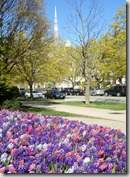 I was never particularly fond of Northwestern.
I was never particularly fond of Northwestern.
The school was impersonal and indifferent; long winters along the windy lakefront were brutal. The professors were excellent and the facilities were superb, but the program had huge gaps in my interest areas. I’m a signals guy and the only signals professor was a tenured EE whose passion was asserting that the Holocaust never happened.
It made the path to a degree uncertain. Where European schools are focused on doing three year’s time and publishing a small collection of papers, our American programs were all about persevering until you’d done enough and wanted out badly enough. Only when a student said “I’ve had it, I’m leaving”, would they get permission to write and defend their dissertation. Our unofficial mascot was Theodore Streleski, the Stanford mathematics graduate student who bludgeoned his advisor to death with a hammer after failing to earn his doctorate.
It’s strange to return to those halls. Our department was at the northwest corner of tech, overlooking the lake (now overlooking recreational sports facilities). The stairs with red standpipes, the bulky brick walls, the open ceiling full of pipes, wires, and florescent lighting, all were unchanged. The visual processing laboratory, where I teased out the relationship between brain and vision, was still there; a few familiar faculty names dotted the abstracts along the walls. An office sign revealed that a former post-doc was now a full professor. Graduate student spaces had moved from heavy wooden desks to cloth and metal cubicles.
The department office was modern; Gwen, our assistant, was long gone. The same job openings and occupational warnings filled the bulletin board outside. There was a plaque announcing participation in the Biomedical Education Consortium: it’s eerie how many of those institutions were also waypoints for me over the years. Maybe it’s inevitable within a small field.
Outside, the open spaces, once grass or parking lots, had all been filled in with massive buildings. The observatory and computer center were gone (quaint, now, to remember going to a Center to do my computing). Academic halls of Molecular Therapeutics and Diagnostics or Executive Education fill old roadways and footpaths. It all appears to have grown and connected,like the images of colonizing biofilms that we’re preventing in CamStent.
The cafeteria has gone commercial; the bookstore virtual. The only sign of political awareness is for student activity board president. The library is busy (for how much longer); a new sculpture garden fills the old summer-stick theater space. And more buildings- theater, music, art, all named after benefactors and their parents in bold signage. It looks like the blond brick and sandstone of Cambridge from some angles.
I spent a few hours touring around the campus, remembering places, people, events. The building where I took a mime class, the paths where I walked on dates, the professor’s house where a mentor reminded me that ideas always have to come before tools. A lot of the old feel of an academic grove, thoughtful and contemplative, is long gone. It feels like the buildings shelter and separate departments rather than bring them together for collaboration and fertilization.
It gave me a good launch in life, strong friendships and credentials for the succeeding 30 years. But it feels like a touchstone, not a home: still someplace I’m glad to have moved on from.











